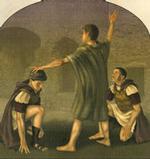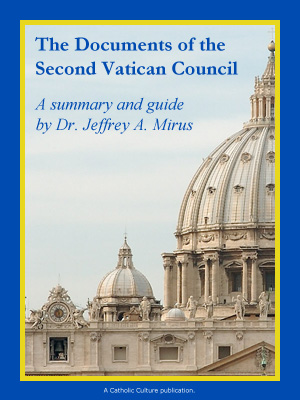Church Compositions Without Liturgical Foundation, Part One
I. Irreverent Treatment Of The Sacred Text
The choir director placed a parcel on the table, saying, "In this package is the new Mass which I composed. The singers like it and say it's awfully pretty." A mere glance at the pages was sufficient to show that the melodic themes were drawn, not from sacred sources, but from the storehouse of a mind rich in personal inventions and reminiscences. They were sweet and sugary ups and downs from tonic to dominant and subdominant, surprising sallies into distant tonalities, dashing solos and bombastic climaxes. The syllables were chased about like rabbits in the brush to get them landed in the preconceived melodic network.
"But, my dear composer, are you aware that you are maltreating words of prayer? Have you ever come across such a treatment of the sacred text when you sang Gregorian chant?"
"In our choir we don't sing the Gregorian chant. We don't like it; in fact, we don't know it. That's why I have written this Mass, and believe me, my whole heart is in it. This is the only kind of music we like. The Gregorian chant has no melody; that is why we keep it out of our repertoire."
This little dialog is not fiction, but a live specimen of compositorial attitude — thirty years after the issuance of the famous Motu Proprio of His Holiness Pius X. The composer in question was a man of unquestionable sincerity, a great worker for the Church, a mainstay of the volunteer choir. He had the best of intentions and, humanly speaking, was deserving of unstinted praise.
When we study in music history the gradual decline and fall of church music, beginning with the arch-innovator Claudio Monteverde in Florence and the modernists in Venice and later in Naples, we are surprised to find a newfangled harmonic treatment of church music making its way into the sanctuary. Unbidden, uninvited, the new harmonies enter with the haughty mien of the Pharisee in the Gospel. With a sneer at the sacred chant and the strict ecclesiastical polyphony they seem to say, "Here we are, in the name of Renaissance and humanistic progress, and we are going to stay." Yes, they did stay; they stayed for three hundred and more years.
Upon the threshold of the twentieth century there appeared a man, clothed in white, and his prophetic name was "Ignis ardens — Burning fire." Like another Elias, he stopped the intruder. With mighty authority he gave orders to the entire Christian army: "Change the course; abandon the byways of harmony, and return to the royal highway of noble melody." The world stood aghast. "What does he mean?" was asked. The man in white proclaimed that music in church must be a prayer and not an entertainment; that every word of it must be reverently uttered by the singers and clearly understood by the faithful, and that henceforth every form of church music which fails in this respect must be mercilessly banished from the house of God.
The composer whom we met at the beginning of this article is one of the great number who have not yet grasped the idea of the Motu Proprio. What the Pope has proclaimed, bishops and priests must repeat and explain in season and out of season. The present lesson is of such simple and elementary nature that no one can excuse himself by saying "I am not a musician." We are concerned with the honor of God's word, with the presentation of the sacred text in a manner that is reverent and intelligible.
Three essential principles have at all times been considered by holy Church as the very foundation of her music: (1) The reverent treatment of the sacred text. (2) The subordination of melody to the text. (3) The diatonic element in the realm of melody. These principles were seriously attacked in the time of Renaissance. A struggle ensued which lasted down to our own days. The struggle is not over; much ignorance and indifference remains, even though light is dawning gradually. Modern music itself is struggling with germs of decay and dissolution, thus forcing, as it were, thinking Catholics to pay greater attention to the sane and sound principles of sacred music.
In his Motu Proprio Pius X says: "The sacred text is presented (in liturgy) to be understood by the faithful." According to the dictates of sound reason, things should never have been otherwise: man wants to understand what is being sung. Besides, acting to the principles of faith, man ought to listen with increased attention and reverence when the word of God is presented to him. And so it was in the Ages of Faith. The church-goers, most of whom could not read, depended completely upon the clear and distinct presentation of the text by the singers. But what happened after the art of printing had been invented, when a large percentage of church-goers could read and afford to procure books? A strange coincidence indeed, but from that time on the presentation of the sacred text became less careful and distinct. By the time of Pope Pius IV the pronunciation had become so involved that in many instances it sounded "like the cackling of hens and the crowing of roosters," since all the vowels were often pronounced at the same time, owing to the overlapping of the musical parts in counterpoint, fugue and imitation work.
Another interference with the understanding of the text resulted from the practice of uniting other words with the words of the liturgy. For instance, they took for their theme the plainchant melody of the Ave Maria, to which three of the voices sang the words of the Kyrie, Gloria, etc., and the remaining voice sang the text as well as the melody of the Ave Maria itself. Hence the titles given to the Masses, "Iste Confessor," "Ave Maria," "Ecce Sacerdos," etc. Even Palestrina himself in his earlier works conformed to this fashion. But worse than this, not only were sacred words sung to secular tunes, even the words were sung also by one of the voices. Thus while soprano, alto, and bass might be singing "Ad te levavi oculos meos," the tenor (always the agent in this shameless violation of decency) might sing "Fair lady, please, sing to me." This it was that roused the ire of the Fathers of Trent, and, hopeless to stem the torrent by any decrees to regulate or control abuses, they were on the point of banishing figured music forever from the Church and permitting nothing but plainchant, when the orators of the emperor and the Spanish bishops craved a respite.
In Session 22 this respite came. A decree was passed forbidding all light, wanton, or impure music in the Church, whether on the voice or on the organ. The Great Council came to a close in 1563, and Pope Pius IV, anxious to enforce the observance of all that was decreed therein regarding church music, lost no time in formulating a plan. He nominated a Congregation of eight Cardinals, among whom was St. Charles Borromeo and Cardinal Ghisleri, the subsequent Pope St. Pius V. This Congregation met for the first time on January 10, 1565, and a sub-commission of eight experts was appointed to examine and report on the best method of reform. Several meetings were held between the Cardinals and the sub-commission, and the following heads were agreed upon: (1) Motets and Masses with a mixture of different words to be set aside. (2) Masses composed on profane themes to be perpetually excluded. (3) Motets with words not liturgical to be no longer used.
The possibility of the words being better understood in figured music was warmly discussed. The Cardinals insisted on this. The experts said that, however desirable this might be, it was not always possible, since the prevailing method of writing in fugue and imitation sometimes covered the words. Finally, with the concurrence of all, it was resolved to ask Palestrina, the chapel master of St. Mary Major's, to write a Mass which should be grave, ecclesiastical, free from all profanity in theme, melody and rhythm; and so constructed that, whilst of pure harmony, the words might be clearly understood despite the laws of fugue and imitation. Palestrina went to work on this task with some diffidence. For greater security he composed three Masses. All were heard by the Commission and gave intense satisfaction, but of the three the one written for six voices, and afterwards dedicated to the memory of Pope Marcellus II, won the palm as thoroughly fulfilling all the conditions imposed. Thus Palestrina saved figured church music. Thus did he bring a practical remedy for prevailing abuses, furnish a model for all time of true ecclesiastical music, artistic in the highest degree, whilst eminently liturgical, and prove in the Missa Papae Marcelli that the Spirit of God that ever abides with His Church is the highest and purest source of inspiration for those who would dedicate the refined arts to her service.
One of the principal reasons why Mother Church treasures so highly her own inherited chant is the eminent manner in which it treats the sacred text. Being essentially unison, there is no overlapping of syllables, no marring of phrases; every division of the sentence appears in the natural order of text delivery; melody helps to make the meaning more impressive.
The Palestrina style agrees very well with plainchant. For this reason it has always been recommended for the greater basilicas, cathedrals, seminaries and institutions. Modern music has also been allowed in church, provided it does not offend against the laws of liturgy.
Corollaries: (1) Holy Church has four official books in which her music is contained: the Gradual, the Antiphoner, the Ritual and the Pontifical. There is only a small percentage of poetry in these books, all the rest being prose. In composing prose-texts, the greatest care has been taken that the words, phrases, clauses and sentences are set forth clearly and distinctly.
(2) Having always been generous in the admission of art into her liturgy, Mother Church has admitted polyphony on condition that it treat reverently the sacred text. The marvels of polyphonic art reached their climax in the Palestrina style. There have been noble imitators of worshipful polyphony up to the present day.
(3) On the other hand, a period of decline and fall from the right principles has asserted itself and led the way to merely secular music in the Church. This style of music stands convicted of irreverent treatment of the word of God.
(4) Since Holy Church is identical with Christ living through the ages, she has from time to time driven out from the temple "the buyers and sellers" of secular lore. Perhaps the most comprehensive temple-cleaning has taken place under the Popes Pius X and XI. The entire priesthood of the Catholic Church is expected to cooperate in this gigantic labor. Nor is this expectation beyond reach of accomplishment in so far as the first fundamental, viz., the worthy treatment of the sacred text, is concerned.
Church Compositions Without Liturgical Foundation, Part Two
This item 4312 digitally provided courtesy of CatholicCulture.org






